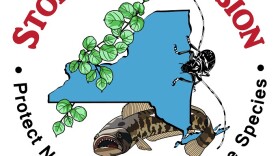The Lake Champlain Basin Program confirmed late last week that the invasive spiny water flea has entered Lake Champlain. The zooplankton threatens to disrupt the food chain and could become a nuisance to anglers.
The confirmation of the spiny water flea in Lake Champlain was not unexpected. Lake researchers had raised warning flags for more than a year that the tiny crustacean was in the Champlain Canal and its incursion into the lake was imminent.
Lake Champlain International Executive Director James Ehlers says they’ve had reports for several months from boaters and anglers that the spiny water flea has been present. “In all likelihood this one was entirely preventable but for want of government action. The Basin Program actually asked us to back off when we started pressuring the New York State Canal Corporation a couple years ago. Whatever politics were involved between the delegation in Vermont and the delegation in New York we’re not privy to, but we were assured that the Army Corps of Engineers and the Canal Corporation were going to be good stewards and the money was in place to move forward. Well, you can see the result.”
The spiny water flea has not entered any water body similar to Lake Champlain so the ecological implications are unknown. Lake Champlain Committee Staff Scientist Mike Winslow says there are several predictions regarding its potential impact, including food chain competition and a possible increase in mercury concentrations in fish due to a shift in its bio-accumulation in the food chain. Winslow is frustrated that warnings went unheeded. “It’s incredibly frustrating. It’s especially frustrating knowing how many more species there are still coming through the canals that can make it to the lake. Round gobies, hydrilla, a bunch of other stuff that can still get here and we really don’t feel like we’re any closer to having a barrier in the canal than we were when we raised this issue eight years ago.”
Adirondack Park Invasive Plant Program Director Hilary Smith notes that every new invasive can disrupt the ecosystem, and the spiny water flea is no exception. “With the water flea it’s an invasive zooplankton and it’s a voracious feeder on other native zooplankton. So there is the possibility of having cascading impacts to the fishery in addition to being a nuisance to anglers.”
New York Governor Andrew Cuomo Tuesday signed a bill that targets preventing the spread of aquatic invasive species by mandating the removal of visible vegetation and animals and draining water when entering and leaving boat launches. Lake Champlain Basin Program Invasive Species Management Coordinator Meg Modley says it reinforces their clean drain and dry message. “The governor signing that bill is reinforcing a spread prevention message that I think will help reduce the risk of all invasive spread from water body to water body.”
The Eurasia native is the first invasive zooplankton to enter Lake Champlain. There is no known predator nor control method for the spiny water flea in Lake Champlain. The crustacean was found in New York's Lake George and the Champlain Canal in 2012. Both flow into Lake Champlain.






